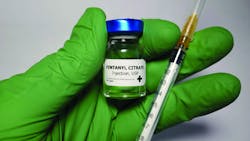The Analytical Challenges with Fentanyl Analysis - A Roundtable
By VUV Analytics
Editor's Note: Being unable to attend personally, we requested VUV Analytics to supply a recap of their event in Washington D.C.
On August 8 2018, VUV Analytics hosted an Executive Roundtable Discussion on the analytical challenges associated with fentanyl analysis. The focus of the Executive Roundtable was the introduction and implementation of new technologies to address the dynamic challenges associated with opioid analysis. Dr. Ira Lurie, a research professor at George Washington University, and Dr. John Goodpaster, professor and head of Forensic Studies at Indiana University – Purdue University Indianapolis (IUPUI) spoke to a crowd of Scientists and Lab Managers from the DEA, United State Postal Inspection Services, NIST, Maryland State Police, and Montgomery County Sheriff’s Department.
"The VUV Analytics Roundtable discussion was very informative about complimentary technology available to identify positional isomers that have similar mass spectral fragmentation…Attending seminars like the VUV Analytics Executive Roundtable on fentanyl analysis helps promote technical growth for drug trends in drug chemistry."
—Noel Vadell, Senior Scientist, DEA Northeast Regional Laboratory
Dr. Lurie, detailed advances in both separation and detector techniques to aid in the differentiation of isomeric synthetic cathinones, cannabinoids, and fentanyl analogues. His research on forensic isomer discrimination employs multi-dimensional liquid chromatography with ultraviolet detection, supercritical fluid chromatography (SFC), and gas chromatography with vacuum ultraviolet absorption (VUV) spectroscopy. VUV spectroscopy is a universal gas-phase GC detector technology that offers strong isomer discrimination through unique spectra (120-240nm) for most categories of drugs of abuse including: opiates, fentanyl, cocaine, cathinones, phenethylamines, cannabinoids, and barbiturates. He presented data showcasing the spectral differentiation of emerging fentanyl species: crotonyl fentanyl and cyclopropyl fentanyl. Dr. Lurie found, in conclusion, that VUV spectroscopy paired with mass spectrometry will maximize the detection capabilities of forensics labs facing the dynamic challenge of synthetic drug ID.
Synthetic drug analyzation
“The VUV Analytics Roundtable discussion was very informative about complimentary technology available to identify positional isomers that have similar mass spectral fragmentation,” says Noel Vadell, a senior scientist with the DEA Northeast Regional Laboratory. “Dr. Lurie and Dr. Goodpaster’s presentations focused on the struggles many forensic labs have confirming fentanyl analogues via traditional GC/MS and GC-FID. VUV detection provides far more analytical data than FID detectors, which solely provide retention time data. VUV spectroscopy provides structural information complementary to mass spectrometry data for drugs with similar fragmentation patterns and that coelute. Attending seminars like the VUV Analytics Executive Roundtable on fentanyl analysis helps promote technical growth for drug trends in drug chemistry.”
Following presentations by Dr. Lurie and Dr. Goodpaster, a roundtable discussion was held to discuss the challenges associated with analyzing synthetic drug species. Scientists from the DEA, USPIS, Montgomery County Sheriff, Maryland State Police, and NIST identified several issues impacting their ability to effectively and efficiently analyze these compounds, leading to longer backlogs that impact ongoing casework of law enforcement agencies. Attendees agreed that new technologies like vacuum ultraviolet spectroscopy, that reduce reliance on certified reference materials (CRMs) for drug identification, accelerate analysis time and provide real-time confirmation will increase lab efficiency, reduce backlog, and provide greater confidence in results.
As law enforcement agencies struggle to address the growing opioid crisis, the Federal government looks to empower forensic labs to reduce backlog through NIJ grant opportunities. Both Dr. Lurie and Dr. Goodpaster received their funding to study VUV spectroscopy for isomer differentiation through the NIJ and its commitment to solving the opioid crisis.
The Roundtable discussion ended with the conclusion that VUV spectroscopy offers a unique solution to the dynamic and difficult challenges posed by fentanyl analogues and synthetic cathinones and cannabinoids.
VUV Analytics would like to thank Dr. Ira Lurie and Dr. John Goodpaster as well as the attendees from DEA, USPIS, Maryland State Police, Montgomery County Sheriffs Department and NIST for attending, presenting and participating in the Executive Roundtable on the Analysis of Drugs of Abuse.
To learn more about VUV Analytics, visit our website at VUVanalytics.com or email [email protected].
